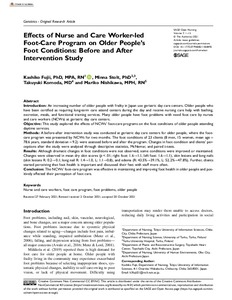Effects of Nurse and Care Worker-led Foot-Care Program on Older People's Foot Conditions: Before and After Intervention Study
Fujii Kashiko; Stolt Minna; Komoda Takuyuki; Nishikawa Mariko
Effects of Nurse and Care Worker-led Foot-Care Program on Older People's Foot Conditions: Before and After Intervention Study
Fujii Kashiko
Stolt Minna
Komoda Takuyuki
Nishikawa Mariko
Sage
Julkaisun pysyvä osoite on:
https://urn.fi/URN:NBN:fi-fe2022012710813
https://urn.fi/URN:NBN:fi-fe2022012710813
Tiivistelmä
Introduction: An increasing number of older people with frailty in Japan use geriatric day care centers. Older people who have been certified as requiring long-term care attend centers during the day and receive nursing care help with bathing, excretion, meals, and functional training services. Many older people have foot problems with need foot care by nurses and care workers (NCWs) at geriatric day care centers.Objective: This study explored the effects of NCWs' foot-care programs on the foot conditions of older people attending daytime services.Methods: A before-after intervention study was conducted at geriatric day care centers for older people, where the footcare program was presented by NCWs for two months. The foot conditions of 23 clients (8 men, 15 women, mean age= 78.6 years, standard deviation = 9.2) were assessed before and after the program. Changes in foot condition and clients' perceptions after the study were analyzed through descriptive statistics, McNemar, and paired t-tests.Results: Although dramatic changes in foot conditions were not observed, some conditions were improved or maintained. Changes were observed in mean dry skin scores (p <.01; right foot: 1.6 -> 1.1, left foot: 1.6 -> 1.1), skin lesions and long nails (skin lesions R: 0.2 -> 0.1; long nail R: 1.4 -> 1.0 L: 1.1 -> 0.8), and edema (R: 43.5%-> 39.1%, L: 52.2%-> 47.8%). Further, clients started perceiving that foot health is important and discussed their feet with staff more often.Conclusion: The NCWs' foot-care program was effective in maintaining and improving foot health in older people and positively affected their perception of foot care.
Kokoelmat
- Rinnakkaistallenteet [27094]
